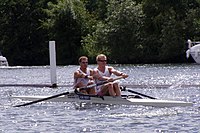
Rowing, sometimes called crew in the United States, is the sport of racing boats using oars. It differs from paddling sports in that rowing oars are attached to the boat using oarlocks, while paddles are not connected to the boat. Rowing is divided into two disciplines: sculling and sweep rowing. In sculling, each rower holds two oars—one in each hand, while in sweep rowing each rower holds one oar with both hands. There are several boat classes in which athletes may compete, ranging from single sculls, occupied by one person, to shells with eight rowers and a coxswain, called eights. There are a wide variety of course types and formats of racing, but most elite and championship level racing is conducted on calm water courses 2 kilometres (1.2 mi) long with several lanes marked using buoys.
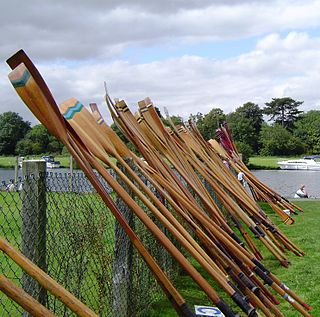
An oar is an implement used for water-borne propulsion. Oars have a flat blade at one end. Rowers grasp the oar at the other end.

Rowing is the act of propelling a human-powered watercraft using the sweeping motions of oars to displace water and generate reactional propulsion. Rowing is functionally similar to paddling, but rowing requires oars to be mechanically attached to the boat, and the rower drives the oar like a lever, exerting force in the same direction as the boat's travel; while paddles are completely hand-held and have no attachment to the boat, and are driven like a cantilever, exerting force opposite to the intended direction of the boat.

In watercraft, a racing shell is an extremely narrow, and often comparatively long, rowing boat specifically designed for racing or exercise. It is outfitted with long oars, outriggers to hold the oarlocks away from the boat, and sliding seats. The boat's long length and semicircular cross-section reduce drag to a minimum. This makes the boat both fast and unstable. It must be balanced by the rowers to avoid tipping. Being able to balance – or "set" – the boat while putting maximum effort into the oars is therefore an essential skill of sport rowing.
In competitive rowing, the following specialized terms are important in the corresponding aspects of the sport:

In rowing, oars are used to propel the boat. Oars differ from paddles in that they use a fixed or sliding fulcrum, an oarlock or rowlock attached to the side of the boat, to transfer power from the handle to the blade, rather than using the athlete's shoulders or hands as the pivot-point as in canoeing and kayaking.

A coxless pair is a rowing boat used in the sport of competitive rowing. It is designed for two rowers, who propel the boat with sweep oars.
In the sport of rowing, each rower is numbered by boat position in ascending order from the bow to the stern. The person who is seated on the first seat is always the 'bow', the closest to the stern is commonly referred to as the 'stroke'. There are some exceptions to this: Rowers in continental Europe number from stern up to bow. Certain crew members have other informal titles and roles. Stroke seat in most cases is responsible for keeping pace for the boat, while the coxswain is responsible for the steering of the boat.

In rowing, the stroke is the action of moving the oar through the water in order to propel the boat forward. The two fundamental reference points in the stroke are the catch where the oar blade is placed in the water, and the extraction where the oar blade is removed from the water. After the blade is placed in the water at the catch, the rower applies pressure to the oar levering the boat forward which is called the drive phase of the stroke. Once the rower extracts the oar from the water, the recovery phase begins, setting up the rower's body for the next stroke.

A single scull is a rowing boat designed for a single person who propels the boat with two oars, one in each hand.
Boats used in the sport of rowing may be adjusted in many different ways according to the needs of the crew, the type of racing, and anticipated rowing conditions. The primary objective of rigging a boat is to accommodate the different physiques and styles of rowing of the crew in such a way that the oars move in similar arcs through the water, thus improving the crew's efficiency and cohesiveness.

A double scull is a rowing boat used in the sport of competitive rowing. It is designed for two persons who propel the boat by sculling with two oars each, one in each hand.

A quadruple sculling boat, often simply called a quad and abbreviated 4x, is a rowing boat used in the sport of competitive rowing. It is designed for four people who propel the boat by sculling with two oars, or "sculls", one in each hand.
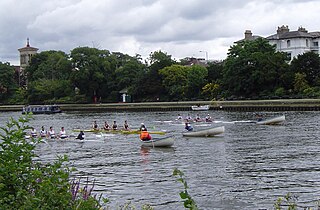
A coxed four, also known as a 4+, is a rowing boat used in the sport of competitive rowing. It is designed for four persons who propel the boat with sweep oars and is steered by a coxswain.
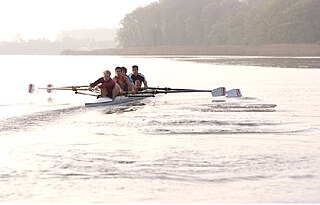
A coxless four is a rowing boat used in the sport of competitive rowing. It is designed for four persons who propel the boat with sweep oars, without a coxswain.

A coxed pair is a rowing boat used in the sport of competitive rowing. It is designed for two persons who propel the boat with sweep oars and is steered by a coxswain.
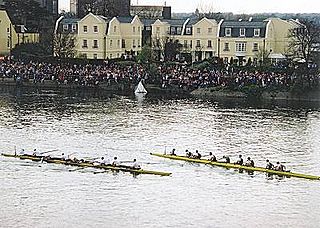
An eight is a rowing boat used in the sport of competitive rowing (crew). It is designed for eight rowers, who propel the boat with sweep oars, and is steered by a coxswain, or "cox".

Sweep rowing is one of two disciplines of the sport of rowing. In sweep rowing each rower has one oar, usually held with both hands. As each rower has only one oar, the rowers have to be paired so that there is an oar on each side of the boat. In the United Kingdom, rowing generally refers to sweep rowing only. The term pulling was also used historically. In the other rowing discipline, sculling, each rower holds two oars, one in each hand.

Human-powered watercraft are watercraft propelled by human power.

Stern sculling is the use of a single oar over the stern of a boat to propel it with side-to-side motions that create forward lift in the water. It is distinguished from sculling, which is rowing with two oars on either side of the boat and from sweep rowing, whereby each boat crew member employs a single oar, complemented by another crew member on the opposite side with an oar, usually with each pulling an oar with two hands.




















